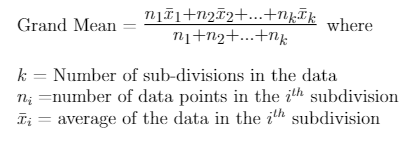In this article, we list the eight most important properties of the mean. The arithmetic mean of a given set of data values is denoted by the symbol X̄.
1) If we add a constant to the given data set, then the new mean is obtained by adding the same constant to the old mean.
For example, if we have a set of values 1,2,3, and 4 whose mean is 2.5 then, if we add 8 to each of the data values the new mean is equal to 8+2.5=10.5. This can be verified as follows:
New Mean = 9+10+11+12/4 = 42/4 =10.25.
2) If we multiply the given data set by a fixed constant, then the new mean is obtained by multiplying the old mean by the same constant.
For example, if we have a set of values 2,3,5, and 6 whose mean is 4 then, if we multiply each of the data values by 3 the new mean is equal to 3*4=12. This can be verified as follows:
New Mean = 6+9+15+18/4 = 48/4 =12.
3) The sum of deviations of the items from the arithmetic mean is always zero.
4) The mean is affected by the value of every item in the series.
5) It is reliable in the sense that it does not vary too much when repeated samples are taken from one and the same population.
6) Since the mean depends on each and every value of the series, it is greatly impacted by the presence of outliers. The outliers are extreme values that can make the mean either extremely large or extremely small.
7) The sum of squared deviations of the items from the arithmetic mean is minimum, that is, less than the sum of squares of deviations from any other value. This is a very important property in regression analysis.
8) If we have two groups of sizes n1 and n2 and means X̅1 and X̅2 then, we can calculate the combined mean/grand mean using the formula,
